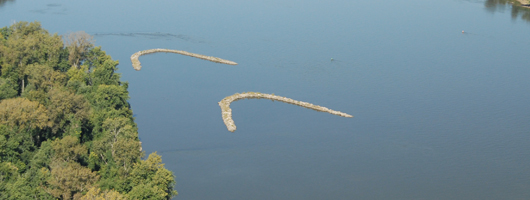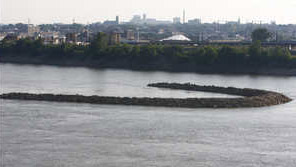
Corps of Engineers shows off river projects on Mississippi
Posted on October 9, 2009
BY WALLY SPIERS - News-Democrat
Gone are the days when the U.S. Army Corps of Engineers did what it wanted and told everyone else afterward. The corps is heavily involved in cooperation now and held the River Engineering Open House on Friday in the St. Louis Harbor on the Mississippi River. The corps hosted an assortment of people from other regulatory agencies, industry, academia and the press aboard the Motor Vessel Mississippi, a gleaming five-story towboat.

Col. Thomas O'Hara, commander of the St. Louis District of the Corps, said they have a lot of different jobs, not only assisting river navigation, but also helping with environmental affairs. "We have a diverse group of people here," he said. "Our idea is to share information and share ideas." The corps was first charged with maintaining a navigation channel in 1880 but now a big part of their mission also is working with others to make sure they take care of the environment.
Joyce Collins, chairwoman of the River Resource Action Team and an employee of the U.S. Fish and Wildlife Service, said before, other agencies would only learn about river projects when it was too late to contribute. But they started getting more cooperation in the mid-1990s and now more viewpoints and contributions are taken into account, coordination is formalized and things are much better, she said. She praised the work done by the Applied River Engineering Center in St. Louis, where river improvements can be replicated in models in a lab and tested for effectiveness.
The open house talked about a lot of different engineering structures along the river but the ones highlighted on the towboat cruise were the three chevrons near the McKinley Bridge and the extended trailing dike coming out of the Chain of Rocks Canal. The chevrons, 250 feet across and 250 feet long, are large V-shaped rock structures that point upstream. They divert the river current and use it to scour deeper channels to keep the navigation channel open and open the barge terminals along the west bank that had been clogging up. The chevrons will create sandbars and aid fish and wildlife habitat. The trailing dike helps align the navigation channel beneath the bridges.
Eddie Brauer of the corps said the dredging of the area was costing $1 million a year. The chevron construction was finished in April 2008 at a cost of $5.5 million which should pay for itself in a little over five years. "A couple of months afterward, we already were seeing the positive effects," he said. The project was the result of a lot of study in the lab using various alternatives and then picking the most effective one with the fewest problems.
Contact reporter Wally Spiers at wspiers@bnd.com or 239-2506.
